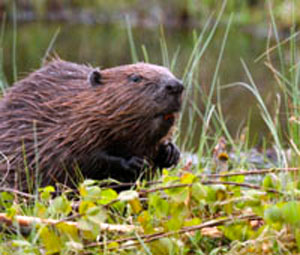Re-introductions and rewilding

Rewilding is a word that has been used often by the media in recent times. Broadly speaking, it refers to the re-introduction of species to areas or habitats where they have 'died out', in some cases hundreds of years ago. The list of animals considered for rewilding varies, but the elk, wolf, lynx, wild boar, beavers and bears are possible candidates.
Bears probably disappeared from the UK sometime in the 12th century, the lynx in mediaeval times, and the last grey wolf was recorded as being killed in Scotland in the 1700s. The loss of such species may be associated in part with hunting but also the loss of forest and the clearance of woodland over the centuries.
It is not certain when beavers disappeared from our landscape; they were hunted for meat and fur until the end of the 16th century. Apart from the occasional escape (and recapture from wildlife parks), beavers have probably been absent for some 400 years, until now. This May a small-scale release of beavers has taken place in Knapdale Forest (near Tayvallich), Argyll and Bute. This trial involves some 3 beaver families and is supervised by the Royal Zoological Society of Scotland and the Scottish Wildlife Trust. The beavers were brought to the UK last year, and kept in quarantine in Devon until their release. It is thought they will need some time to 'settle in' and establish their territories. After this, visitors are welcome to the Knapdale Forest, which is a Forestry Commission Scotland woodland, managed in partnership with the Scottish Wildlife Trust.
Beavers are exclusively vegetarian, mainly aquatic and tend to be most active at dawn or dusk. They eat water plants, and the leaves, bark and branches of trees such as oak, birch, rowan, alder and willow (they are not particularly partial to conifers). The beaver is the largest European rodent, ranging in length from 100 to 140 cm. In the wild, their life span is probably 7 to 8 years; they mate for life and a pair will usually produce a litter each year, with 2 or 3 kits.
Beavers are also noted as 'environmental engineers' due to their ability to build dams and lodges; they store their harvested woody material underwater; it is these activities that have raised concerns for some. Scottish Natural Heritage is tasked with monitoring this project and the ecological impact of the beavers. For more information on these 'Scottish' beavers, and indeed beavers in general, visit www.scottishbeavers.org.uk.
One reintroduction that has been less controversial is that of the large blue butterfly. This was lost from the UK landscape in the late 1970s. The numbers of the large blue were reduced (especially in areas like Cornwall and the Cotswolds) to very low levels by over-zealous lepidopterists. Even when such collecting was banned, the numbers of the butterfly continued to decline. This was associated with the decline in grazing by sheep, cattle and rabbits (the effect of myxomatosis on the latter); consequently traditional grasslands became overgrown. Such grasslands were the habitat that the large blue needed to complete its life cycle with some help from a particular species of ant (Myrmica sabuleti). Through the work of Professor Jeremy Thomas (Oxford) and David Simcox (CEH), the large blue has been successfully reintroduced to restored and managed meadows in the South West of England.
In some parts of the country, such as the Forest of Dean, wild boars have reappeared; these probably originated from escapees or small numbers released into the wild. However, they have bred rapidly (absence of predators and mild winters), so that they are now several sounders. A sounder is a group of sows and juveniles, led by a dominant sow. There have been various reports of damage and concern by local communities. Similar population growth and concerns have been reported in Germany and Austria. The Forestry Commisssion has sent staff to other EU countries to learn about 'best practice' in keeping such animals away from built-up areas and the culling of specific problem animals.
The re-introduction of a species can be particularly controversial, especially when it involves a carnivore such as the lynx or wolf. At the Alladale Estate in Sutherland, Paul Lister would like to manage deer numbers through the re-introduction of various 'top' carnivores, creating a 'wilderness reserve'. For more information about his ideas read the recent article in the Daily Telegraph http://www.telegraph.co.uk/earth/wildlife/5005213/Born-to-be-wild-again.html.
A number of rewilding projects are underway or planned throughout Europe, which are perhaps less controversial. A database of such programs can be found at http://www.wildland-network.org.uk/projects/wn_rewild_database.htm. An example of one in progress is at Epping Forest where they are attempting to restore ancient woodland pasture through the cutting back of ancient pollarded trees, the removal of 'alien' or introduced species and the clearance of scrub. The idea is to encourage tree and insect species back through the recreation of their natural habitat. Similarly, Wicken Fen in Cambridgeshire is regenerating a natural wetland through the removal of scrub and agricultural land, and a reduction in water drainage. Flowering meadows, sedge and reed beds now provide homes for hen harriers, bitterns and water voles. The fen now supports an amazing variety of wildlife, especially moths, butterflies and dragonflies.
Most will support the idea of recreating natural landscapes and habitats from areas 'despoiled' by human activity, but the thought of 'meeting a wolf' may prove a step too far for many; indeed the release of the beavers is not without controversy as farmers and anglers have expressed concerns about flooding and the possible loss of fish spawning grounds.
Comments are closed for this post.
Discussion
[…] grouse. In the past, these areas also supported the wolf, lynx and bear. In recent times, the European Beaver has been […]

[…] in Swiss woodlands, but it has also contributed to an increase in rarer wild mammals such as wolves, lynxes and even […]
Swiss forestry is growing, especially in the alps | Woodlands.co.uk
4 November, 2013